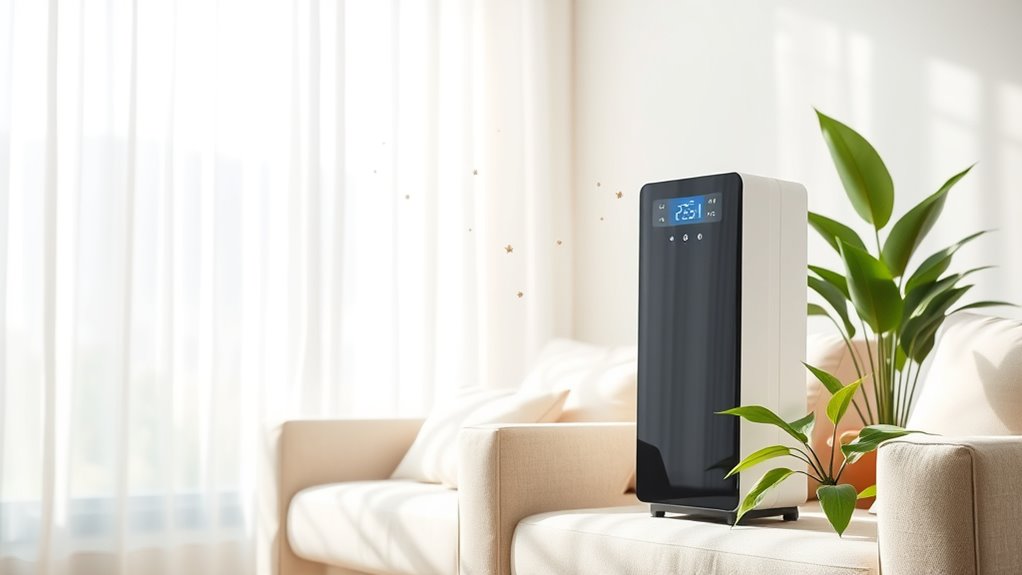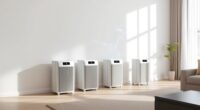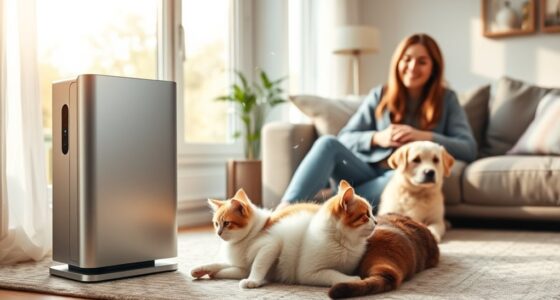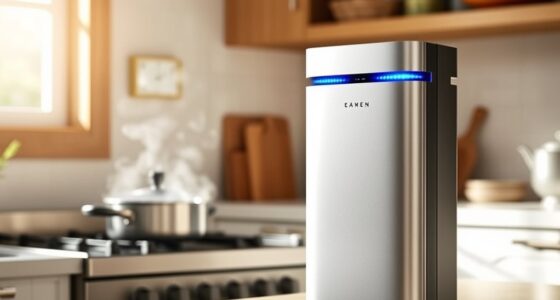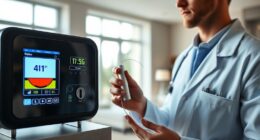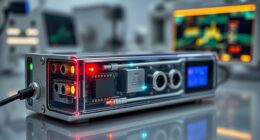During allergy season, air purifiers with HEPA filters can make a big difference by removing up to 99.97% of airborne irritants like pollen, pet dander, and dust mites. This helps reduce your allergy symptoms, such as sneezing and congestion, and creates a safer, cleaner indoor environment. Proper use and regular filter maintenance guarantee ongoing relief. To learn how to maximize their benefits and manage allergy symptoms effectively, keep exploring this helpful information.
Key Takeaways
- HEPA filters trap airborne allergens like pollen, pet dander, and dust mites, reducing triggers that cause allergy symptoms.
- Air purifiers continuously remove irritants from indoor air, helping to lessen sneezing, congestion, and itchy eyes during allergy season.
- Properly sized units and regular filter maintenance ensure maximum allergen removal and improved indoor air quality.
- Air purifiers also eliminate mold spores, bacteria, and some viruses, promoting a healthier indoor environment.
- Using air purifiers offers a proactive approach to managing allergy symptoms and creating a safer, more comfortable space during peak seasons.
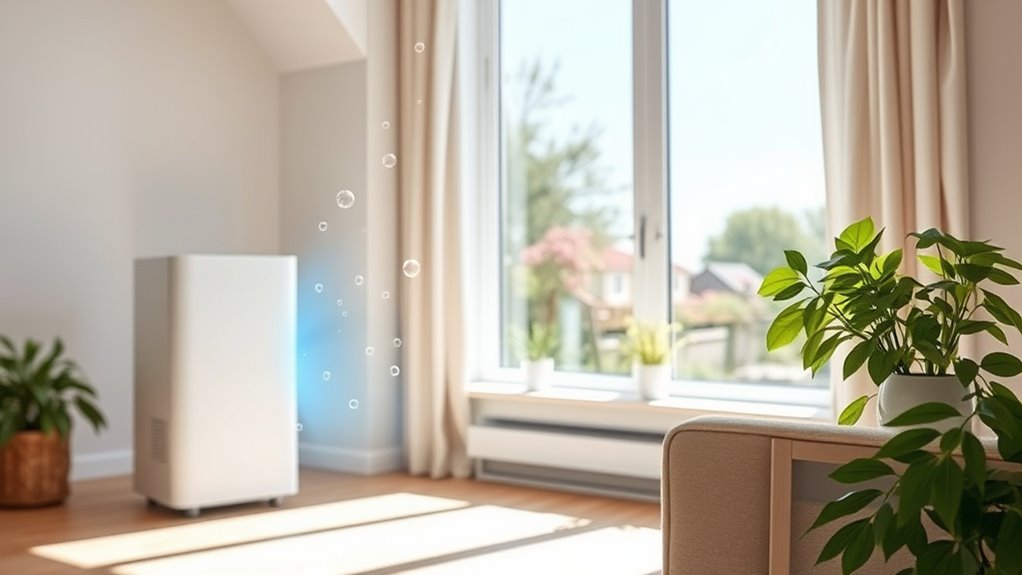
As allergy season approaches, many people find their homes become filled with airborne irritants like pollen, pet dander, and dust mites. These particles can trigger sneezing, congestion, itchy eyes, and even asthma attacks. To combat this, you might consider investing in an air purifier equipped with HEPA filters, which are designed specifically for allergen removal. HEPA filters are highly effective at trapping tiny particles—down to 0.3 microns—making them an essential tool for improving indoor air quality. When you turn on an air purifier with a HEPA filter, it continuously pulls in the surrounding air, capturing allergens before they can circulate and settle in your home. This process not only reduces the overall allergen load but also results in cleaner, fresher air for you to breathe.
Using an air purifier with a HEPA filter can markedly lessen allergy symptoms by removing common triggers from your environment. Pollen particles, pet dander, and dust mites often float freely in the air, especially during peak allergy seasons. By filtering these irritants out, you’re less likely to experience the sneezing fits or congestion that usually accompany outdoor pollen spikes. It’s a simple yet powerful way to create a safer space indoors, where you can relax without constant allergy flare-ups. Making sure the air purifier is appropriately sized for your room ensures maximum allergen removal, so you get the most benefit from your investment.
In addition to allergen removal, a HEPA filter helps eliminate other airborne pollutants like mold spores, bacteria, and some airborne viruses. This makes your indoor environment healthier overall, especially if you or family members have compromised immune systems. Regularly replacing or cleaning the HEPA filter is vital to maintain its effectiveness. Many models come with indicator lights that tell you when it’s time for a change, simplifying maintenance. Because allergens tend to settle on surfaces over time, pairing your air purifier with routine cleaning amplifies its benefits, keeping your home as allergen-free as possible.
Ultimately, incorporating a HEPA filter-based air purifier into your allergy management plan offers a proactive way to breathe easier during allergy season. It continuously removes airborne irritants, reducing your exposure, and alleviating symptoms. While it’s not a cure-all, it’s a meaningful step toward a more comfortable, allergen-controlled environment. With cleaner air circulating in your home, you can enjoy allergy season without feeling overwhelmed by sneezing, congestion, or itchy eyes—making your springtime experience much more bearable.
Frequently Asked Questions
Do Air Purifiers Eliminate All Types of Airborne Allergens?
You might wonder if air purifiers eliminate all airborne allergens, but they don’t. While high-quality models with HEPA filters are effective at allergen elimination, filter limitations mean some tiny particles like certain viruses or gases may still slip through. Air purifiers substantially reduce common allergens like pollen, pet dander, and dust, but they aren’t a complete solution. Combining them with other measures helps you breathe easier during allergy season.
How Often Should I Replace the Filters in My Air Purifier?
It’s funny how a simple routine like filter maintenance can make a big difference. You should replace your air purifier filters based on the recommended schedule, usually every 3 to 6 months. However, if you notice reduced airflow or lingering odors, it’s time for a replacement. Sticking to the right replacement schedule guarantees your device keeps filtering effectively, helping you breathe easier and maintain cleaner indoor air.
Are Air Purifiers Effective Against Mold Spores?
Air purifiers are effective against mold spores, especially those with HEPA efficiency filters. These filters capture tiny mold spores, reducing their presence in your indoor air and aiding mold mitigation. To maximize their effectiveness, make sure your purifier runs continuously and maintains clean filters. While not a complete solution, using an air purifier with HEPA efficiency considerably improves indoor air quality and helps you breathe easier during mold-prone times.
Can Air Purifiers Help With Pet Dander Allergies?
Some might think air purifiers can’t help with pet allergies, but they actually do a great job with dander removal. If you’re tired of sneezing and itchy eyes caused by pet dander, an air purifier can improve your air quality considerably. By trapping pet dander and other allergens, it creates a cleaner environment, making it easier to breathe and reducing allergy symptoms. So yes, air purifiers really make a difference for pet allergy sufferers.
Do Air Purifiers Produce Any Ozone or Harmful Emissions?
You might wonder if air purifiers produce ozone or harmful emissions. Some models, especially those with ionizers or ozone generators, can create ozone production, which may irritate your lungs. However, many modern purifiers are designed to minimize harmful emissions, using HEPA filters instead. To stay safe, choose a purifier labeled as ozone-safe, and avoid devices that emit high levels of ozone or other harmful emissions.
Conclusion
So, why suffer through allergy season when an air purifier can make a real difference? By filtering out pollen, dust, and other irritants, you’ll breathe easier and enjoy the season more. Isn’t it worth making your home a haven of clean, fresh air? Investing in an air purifier isn’t just a convenience—it’s a simple step toward comfort and relief. Take control today and breathe easier all season long.
